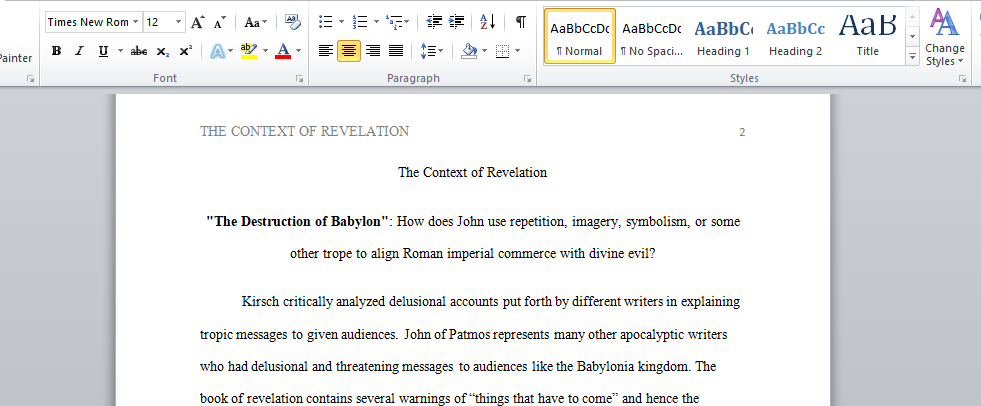Crucial historical background on the book of Revelation
Before you start to write, make sure you have read Kirsch’s chapter “History of a Delusion,”which presents crucial historical background on the Book of Revelation, its author John of Patmos, and his original audience of Asian-Roman Christians.
(For additional information, you may also choose to read the excerpt on Revelation and apocalyptic literature from The Cambridge Companion to the Bible, “The Formation of Christian Communities.”
Use the Metacognitive Tools for Critical Reading to help you understand the ideas and information that Kirsch presents: read aloud and talk to yourself as you go, verbalizing your responses to specific passages. Label each paragraph with its purpose and take notes on main ideas, key evidence, and where you have questions or need to look something up. Yes, it will take longer to read the essay this way! But you’re way more likely to understand what he says if you take your time and pay attention to your responses as you read.
——————————
In Chapter 3, Kirsch points out that in the Book of Revelation, John of Patmos “sets himself against the alluring ways of Greco-Roman civilization as practiced in his own lifetime by the subjects of a superpower that he so memorably dubbed ‘the mother of harlots and abominations of the earth'” (64).
Pick ONE of the main sections of Revelation to focus your response to this week’s main question–broadly speaking, how precisely does John of Patmos use particular apocalyptic tropes to “set himself against” Roman imperial rule, religion, commerce, and culture?
Your answer to one of the questions below should be an arguable claim (an idea that a reasonable person could disagree with).
- “Christ’s Messages to Seven Churches”: How does John use repetition, imagery, figurative language, symbolism, or some other trope to criticize Christians who accommodate themselves to Roman religion? (see Kirsch p. 67-69)
- “Visions of Heaven”: How does John use imagery, symbolism, or some other trope to reject Roman imperial sovereignty?
- “Seven Seals”: How does John use repetition, imagery, symbolism, or some other trope to undermine the perceived stability and prosperity of the Roman imperial order and/or demonstrate the limits of compromising with Roman authority? (see Kirsch p. 75-77)
- “Seven Trumpets”: How does John use repetition, imagery, symbolism, or some other trope to inspire both despair and hope about Roman decadence?
- “Seven Visions”: How does John use imagery, symbolism, or some other trope to align Roman imperial rule (politics) with divine evil?
- “Seven Bowls”: How does John use repetition, imagery, symbolism, or some other trope to present an anti-Roman ideology (system of beliefs/values) of divine justice?
- “The Destruction of Babylon”: How does John use repetition, imagery, symbolism, or some other trope to align Roman imperial commerce with divine evil?
- “More Visions” (Battle of Armageddon and Last Judgment): How does John use imagery, symbolism, or some other trope to appropriate or challenge Roman imperial law and conquest?
- “The New Jerusalem”: How does John use repetition, imagery, symbolism, or some other trope to imagine an alternative to Roman imperial rule?
Some tips for getting started:
- Identify one or perhaps two tropes in Revelation that you find interesting.
- Use your chosen trope(s) to pick the section you’ll focus on. In other words, where does this trope appear prominently in Revelation?
- Reread your chosen section carefully and pay particular attention to the style, tone, descriptions, symbolism, key plot points and characterizations, etc., especially as they affect how your chosen trope is presented in the text.
- Make some notes about what you find interesting about why this trope appears the way it does. Start with your own personal responses and build out from that.
- Then, make some notes about how you think this trope is connected to the larger context of Judeo-Christian life under Roman imperial rule–the pressure to participate in Roman civic religion (the emperor cult), participation in imperial commerce and trade, the (perceived or real) threat of persecution by Roman authorities, or something else.
Once you’ve got a sense of these ideas and evidence, you should be able to start writing your response. Before you submit your response, refer to the CR Exercise Skills Checklist to help you make sure that your analysis is arguable, specific, and well-organized.
Answer preview:

Words: 554
